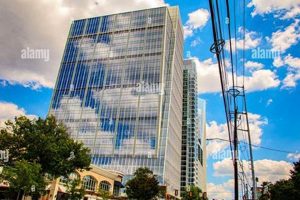Gothic skyscrapers are a type of skyscraper that incorporates gothic architectural elements into its design. They are characterized by pointed arches, ribbed vaults, and flying buttresses. Some of the most famous gothic skyscrapers include the Woolworth Building in New York City and the Tribune Tower in Chicago.
Gothic skyscrapers were popular in the early 20th century, as architects sought to create buildings that were both modern and monumental. Gothic architecture had long been associated with churches and cathedrals, and its use in skyscrapers gave these buildings a sense of grandeur and importance. Gothic skyscrapers also benefited from the development of new construction techniques, such as the use of steel frames, which allowed for the construction of taller and more slender buildings.
Today, gothic skyscrapers are still admired for their beauty and grandeur. They are a reminder of a time when architects were not afraid to experiment with new styles and forms. Gothic skyscrapers continue to inspire architects today, and their influence can be seen in many modern buildings.
1. Height
Gothic skyscrapers are some of the tallest buildings in the world. This is due in part to the fact that they are often built in urban areas, where land is scarce and height is a valuable commodity. Additionally, the Gothic architectural style is characterized by its pointed arches and ribbed vaults, which allow for the construction of taller and more slender buildings.
- Engineering and Construction
Gothic skyscrapers are built using a variety of engineering and construction techniques that allow them to reach great heights. For example, the Woolworth Building in New York City uses a steel frame to support its weight, while the Tribune Tower in Chicago uses a concrete frame. Additionally, gothic skyscrapers often have setbacks at various heights, which helps to reduce wind resistance and make the building more stable. - Architectural Design
The architectural design of gothic skyscrapers also contributes to their height. The pointed arches and ribbed vaults of gothic architecture allow for the construction of taller and more slender buildings. Additionally, gothic skyscrapers often have spires or other decorative elements that add to their height. - Urban Planning
The location of gothic skyscrapers in urban areas also contributes to their height. In cities, land is scarce and height is a valuable commodity. As a result, gothic skyscrapers are often built on narrow lots and have to be built up rather than out. - Cultural Significance
Gothic skyscrapers are often seen as symbols of power and prestige. As a result, they are often built in prominent locations and are designed to be impressive. The height of gothic skyscrapers is one of the things that makes them so impressive and iconic.
The height of gothic skyscrapers is a testament to the skill and ingenuity of architects and engineers. Gothic skyscrapers are a unique and beautiful type of building, and they continue to inspire architects and engineers today.
2. Design
Gothic skyscrapers are designed to be both beautiful and functional. This is evident in the way that they incorporate gothic architectural elements into their design, such as pointed arches, ribbed vaults, and flying buttresses. These elements not only add to the beauty of the building, but they also serve a functional purpose. For example, the pointed arches help to distribute the weight of the building more evenly, while the ribbed vaults help to create a more stable structure.
In addition to their gothic architectural elements, gothic skyscrapers also incorporate modern materials and construction techniques. This allows them to be both beautiful and functional. For example, the Woolworth Building in New York City uses a steel frame to support its weight, while the Tribune Tower in Chicago uses a concrete frame. These materials allow the buildings to be built taller and more slender than traditional gothic buildings.
The design of gothic skyscrapers is a testament to the skill and ingenuity of architects and engineers. They have been able to create buildings that are both beautiful and functional, and that continue to inspire architects and engineers today.
3. Construction
The construction of gothic skyscrapers is a complex and challenging process. Architects and engineers must carefully consider the materials they use and the techniques they employ in order to create buildings that are both beautiful and functional. Historically, gothic skyscrapers were constructed using traditional materials such as stone, wood, and brick. However, modern gothic skyscrapers are more likely to be constructed using steel, concrete, and glass. These materials are lighter and stronger than traditional materials, and they allow for the construction of taller and more slender buildings.
The use of steel frames in the construction of gothic skyscrapers is particularly important. Steel frames provide the building with a strong and stable foundation, and they allow for the construction of buildings that are taller than would be possible with traditional materials. Additionally, steel frames are relatively lightweight, which helps to reduce the overall weight of the building and makes it more resistant to earthquakes and other natural disasters.
Concrete is another important material used in the construction of gothic skyscrapers. Concrete is a versatile material that can be used to create a variety of structural elements, including walls, floors, and columns. Concrete is also relatively inexpensive, which makes it a cost-effective option for the construction of large buildings.
Glass is also an important material used in the construction of gothic skyscrapers. Glass allows for the creation of large windows and curtain walls, which provide natural light and ventilation to the building. Glass is also a relatively lightweight material, which helps to reduce the overall weight of the building.
The construction of gothic skyscrapers is a complex and challenging process, but it is one that has been mastered by architects and engineers over the centuries. The use of modern materials and construction techniques has allowed for the construction of gothic skyscrapers that are taller, stronger, and more beautiful than ever before.
4. History
The early 20th century was a time of great change and innovation in architecture and engineering
. The development of new materials and construction techniques, such as the steel frame, made it possible to build taller and more slender buildings. Architects and engineers also began to explore new architectural styles, including the Gothic Revival style.
- Influence of the Gothic Revival Style
The Gothic Revival style was a popular architectural style in the 19th and early 20th centuries. The style was inspired by the Gothic architecture of the Middle Ages, and it featured pointed arches, ribbed vaults, and flying buttresses. Gothic skyscrapers incorporated many of these Gothic elements into their design, giving them a distinctive and recognizable appearance.
- Technological Advancements
The development of new materials and construction techniques, such as the steel frame, made it possible to build taller and more slender buildings. This allowed architects and engineers to create gothic skyscrapers that were taller than any previous buildings.
- Urbanization and the Need for Skyscrapers
The early 20th century was a time of rapid urbanization. As cities grew, there was a need for taller buildings to accommodate the growing population. Gothic skyscrapers were well-suited to this need, as they could be built to great heights and could accommodate a large number of people.
- Symbolism and Prestige
Gothic skyscrapers were often seen as symbols of power and prestige. They were built by wealthy corporations and individuals who wanted to make a statement about their success. Gothic skyscrapers also became symbols of the cities in which they were built.
The construction of gothic skyscrapers in the early 20th century was a major turning point in the history of architecture and engineering. These buildings were the tallest and most technologically advanced buildings of their time, and they continue to be admired today for their beauty and grandeur.
5. Influence
Gothic skyscrapers have had a profound influence on the design of many other buildings, including churches, cathedrals, and skyscrapers. This is due in part to their unique and distinctive appearance, which is characterized by pointed arches, ribbed vaults, and flying buttresses. These elements have been incorporated into the design of many other buildings, giving them a sense of grandeur and importance.
One of the most notable examples of the influence of gothic skyscrapers is the Chrysler Building in New York City. The Chrysler Building was designed by William Van Alen in the Art Deco style, but it incorporates many gothic elements, such as pointed arches and ribbed vaults. This gives the building a unique and distinctive appearance that sets it apart from other Art Deco buildings.
Another example of the influence of gothic skyscrapers is the Cathedral of St. John the Divine in New York City. The Cathedral of St. John the Divine is a Gothic Revival cathedral that was designed by Ralph Adams Cram. The cathedral is one of the largest and most impressive Gothic Revival buildings in the United States. It incorporates many gothic elements, such as pointed arches, ribbed vaults, and flying buttresses.
The influence of gothic skyscrapers can also be seen in the design of many modern skyscrapers. For example, the One World Trade Center in New York City incorporates many gothic elements, such as pointed arches and ribbed vaults. This gives the building a sense of grandeur and importance that is appropriate for its status as a symbol of the city.
The influence of gothic skyscrapers on the design of other buildings is a testament to their beauty and grandeur. Gothic skyscrapers are a unique and distinctive type of building that continues to inspire architects and engineers today.
6. Popularity
Gothic skyscrapers are popular with both tourists and architects for a variety of reasons. They are often seen as symbols of power and prestige, and they can be very impressive to look at. Additionally, gothic skyscrapers are often located in major cities, which makes them easy for tourists to visit. Architects are also drawn to gothic skyscrapers because of their unique and distinctive design. The pointed arches, ribbed vaults, and flying buttresses of gothic skyscrapers are all elements that can be very inspiring to architects.
- Architectural Significance
Gothic skyscrapers are often seen as architectural marvels. They are some of the tallest and most impressive buildings in the world, and they often feature unique and innovative design elements. This makes them popular with tourists who are interested in architecture and design.
- Historical Significance
Gothic skyscrapers are also popular with tourists because of their historical significance. Many gothic skyscrapers were built in the early 20th century, and they are often seen as symbols of a bygone era. This makes them popular with tourists who are interested in history and culture.
- Cultural Significance
Gothic skyscrapers are also popular with tourists because of their cultural significance. They are often seen as symbols of the cities in which they are located, and they can be a source of pride for local residents. This makes them popular with tourists who are interested in learning about the culture of a particular city.
- Aesthetic Appeal
Gothic skyscrapers are also popular with tourists because of their aesthetic appeal. They are often very beautiful buildings, and they can be a pleasure to look at. This makes them popular with tourists who are interested in art and beauty.
Gothic skyscrapers are a popular tourist destination for a variety of reasons. They are architecturally significant, historically significant, culturally significant, and aesthetically appealing. This makes them a must-see for any tourist who is interested in architecture, history, culture, or art.
7. Symbolism
Gothic skyscrapers, with their towering heights and elaborate ornamentation, have long been associated with power and prestige. This symbolism is rooted in the historical context of Gothic architecture, which was often used for religious and governmental buildings. In the early 20th century, when gothic skyscrapers first began to be built, they were seen as a way to express the wealth and power of corporations and individuals.
- Corporate Power
Many gothic skyscrapers were built by wealthy corporations as a way to showcase their success and dominance in the business world. The Woolworth Building in New York City, for example, was built by Frank Woolworth as a symbol of his retail empire.
- Governmental Power
Gothic skyscrapers were also built by governments as a way to express their authority and power. The Empire State Building in New York City, for example, was built as a symbol of American strength and prosperity.
- Individual Prestige
Gothic skyscrapers were also built by wealthy individuals as a way to display their wealth and status. The Chrysler Building in New York City, for example, was built by Walter Chrysle
r as a symbol of his personal success.
The symbolism of gothic skyscrapers has evolved over time. Today, they are still seen as symbols of power and prestige, but they are also seen as symbols of architectural achievement and beauty. Gothic skyscrapers are a reminder of the human desire to build tall and impressive structures, and they continue to inspire architects and engineers today.
8. Legacy
Gothic skyscrapers are a unique and significant type of building that emerged in the early 20th century. They are characterized by their pointed arches, ribbed vaults, and flying buttresses, which are all elements of the Gothic Revival architectural movement. Gothic Revival architecture was popular in the 19th and early 20th centuries, and it was used for a variety of buildings, including churches, universities, and government buildings.
- Historical Significance
Gothic skyscrapers are a lasting legacy of the Gothic Revival architectural movement because they represent a revival of a historical style. Gothic architecture was first developed in the Middle Ages, and it was used to build some of the most impressive and iconic buildings in the world, such as Notre Dame Cathedral in Paris and Westminster Abbey in London. Gothic skyscrapers are a modern interpretation of this historical style, and they represent a continuation of the Gothic tradition.
- Architectural Significance
Gothic skyscrapers are also a lasting legacy of the Gothic Revival architectural movement because they are architecturally significant buildings. They are often very tall and impressive, and they feature unique and innovative design elements. Gothic skyscrapers are a testament to the skill and ingenuity of architects and engineers, and they continue to inspire architects and engineers today.
- Cultural Significance
Gothic skyscrapers are also a lasting legacy of the Gothic Revival architectural movement because they have cultural significance. They are often seen as symbols of power and prestige, and they can be a source of pride for local residents. Gothic skyscrapers are also popular with tourists, and they can be a major attraction in a city.
Gothic skyscrapers are a unique and significant type of building that are a lasting legacy of the Gothic Revival architectural movement. They are historically significant, architecturally significant, and culturally significant. Gothic skyscrapers are a reminder of the human desire to build tall and impressive structures, and they continue to inspire architects and engineers today.
Frequently Asked Questions about Gothic Skyscrapers
Gothic skyscrapers are a unique and fascinating type of building. They are characterized by their pointed arches, ribbed vaults, and flying buttresses, which are all elements of the Gothic Revival architectural movement. Gothic skyscrapers were first built in the early 20th century, and they continue to be admired today for their beauty and grandeur.
Question 1: What are the defining characteristics of gothic skyscrapers?
Answer: Gothic skyscrapers are characterized by their pointed arches, ribbed vaults, and flying buttresses. These elements are all part of the Gothic Revival architectural movement, which was popular in the 19th and early 20th centuries.
Question 2: When were gothic skyscrapers first built?
Answer: Gothic skyscrapers were first built in the early 20th century. The Woolworth Building in New York City is one of the earliest examples of a gothic skyscraper.
Question 3: Why were gothic skyscrapers built?
Answer: Gothic skyscrapers were built for a variety of reasons. They were seen as symbols of power and prestige, and they were also a way to express the wealth and success of a city.
Question 4: What are some of the most famous gothic skyscrapers?
Answer: Some of the most famous gothic skyscrapers include the Woolworth Building in New York City, the Tribune Tower in Chicago, and the Chrysler Building in New York City.
Question 5: Are gothic skyscrapers still being built today?
Answer: Gothic skyscrapers are still being built today, although they are not as common as they once were. One recent example of a gothic skyscraper is the One World Trade Center in New York City.
Question 6: What is the significance of gothic skyscrapers?
Answer: Gothic skyscrapers are significant because they are a unique and beautiful type of building. They are also a reminder of the human desire to build tall and impressive structures.
Summary: Gothic skyscrapers are a unique and fascinating type of building. They are characterized by their pointed arches, ribbed vaults, and flying buttresses. Gothic skyscrapers were first built in the early 20th century, and they continue to be admired today for their beauty and grandeur.
We hope this FAQ section has been helpful in answering your questions about gothic skyscrapers.
Transition to the next article section: Gothic skyscrapers are a testament to the skill and ingenuity of architects and engineers. They are a reminder of the human desire to build tall and impressive structures, and they continue to inspire architects and engineers today.
Gothic Skyscrapers
Gothic skyscrapers are a unique and fascinating type of building. They are characterized by their pointed arches, ribbed vaults, and flying buttresses, which are all elements of the Gothic Revival architectural movement. Gothic skyscrapers were first built in the early 20th century, and they continue to be admired today for their beauty and grandeur.
Here are a few tips for appreciating and understanding gothic skyscrapers:
Tip 1: Look for the Pointed Arches
Pointed arches are one of the most distinctive features of gothic skyscrapers. They are typically found on the windows, doorways, and other openings of the building. Pointed arches are a structural innovation that allowed Gothic architects to build taller and more slender buildings.
Tip 2: Admire the Ribbed Vaults
Ribbed vaults are another common feature of gothic skyscrapers. They are a type of ceiling that is made up of a series of intersecting ribs. Ribbed vaults are not only beautiful, but they also help to distribute the weight of the building more evenly.
Tip 3: Observe the Flying Buttresses
Flying buttresses are another distinctive feature of gothic skyscrapers. They are a type of arch that is used to support the walls of the building. Flying buttresses are not only functional, but they also add to the beauty of the building.
Tip 4: Learn About the History of Gothic Skyscrapers
Gothic skyscrapers were built in a variety of different styles, and they reflect the different cultures and time periods in which they were built. Learning about the history of gothic skyscrapers can help you to appreciate their unique beauty and significance.
Tip 5: Visit a Gothic Skyscraper
There is no better way to appreciate gothic skyscrapers than to visit one in person. Many gothic skyscrapers are open to the public, and they offer a variety of tours and exhibits. Visiting a gothic skyscraper is a great way to learn more about their history, architecture, and significance.
Summary: Gothic skyscrapers are a unique and beautiful type of building. They are a reminder of the human desire to build tall and impressive structures, and they continue to inspire architects and engineers today.
By following these tips, you can gain a deeper appreciation and understanding of gothic skyscrapers.
Transition to the article’s conclusion: Gothic skyscrapers are a testament to the skill and ingenuity of architects and engineers. They are a reminder of the human desire to build tall and impressive structures, and they continue to inspire architects and engineers today.
Gothic Skyscrapers
Gothic skyscrapers are a unique and fascinating type of building. They are characterized by their pointed arches, ribbed vaults, and flying buttresses, which are all elements of the Gothic Revival architectural movement. Gothic skyscrapers were first built in the early 20th century, and they continue to be admired today for their beauty and grandeur.
This article has explored the history, architecture, and significance of gothic skyscrapers. We have seen that gothic skyscrapers are a product of their time, and they reflect the cultural and technological developments of the early 20th century. We have also seen that gothic skyscrapers are a testament to the skill and ingenuity of architects and engineers. They are a reminder of the human desire to build tall and impressive structures, and they continue to inspire architects and engineers today.
As we look to the future, it is clear that gothic skyscrapers will continue to be a part of our built environment. They are a reminder of our past, and they are a source of inspiration for our future. Gothic skyscrapers are a testament to the human desire to build tall and impressive structures, and they will continue to inspire architects and engineers for generations to come.







